

Full-day country walks in
SE England and beyond
Codicote to St Albans
Click on the image below to access
the full map on plotaroute
Distance: 15.3 miles / 13.5 miles.
Time without long breaks: Apx 8 hours (long) / 7 hours (short).
Terrain: Mostly very easy-going.
How to get there and back: Train from Kings Cross to Knebworth then a bus to Codicote. Alternatively, catch a train to Welwyn Garden City then a cab from outside the station to either Codicote or (if you want to do the shorter version) Ayot St Lawrence. Return by train from St Albans.
Pubs: The Brocket Arms is near the start, while six miles in is the John Bunyan. Sandridge has the Queen's Head. Then it's a long gap until the Six Bells on the outskirts of St Albans, which has plenty to choose from.
More information: This route is suitable for any season (as can be seen from the pictures, we walked it in the snow), although if walking in winter it's advised to choose the shorter version to complete it before sundown.

This walk is one of the easiest to navigate as it mostly follows the Hertfordshire Way long distance footpath, which is well sign- posted throughout. It starts at the small town of Codicote, before visiting one of the area's most beautiful villages, Ayot St Lawrence, and its stunning neo-classical church. The route also includes part of an iron age fort, a great country pub, a Roman theatre and the Childwickbury estate, once home to the film director Stanley Kubrick (see below). You will also cross paths with George Bernard Shaw, John Bunyan and (optional) Francis Bacon. The walk ends in the historic city of St Albans.
If getting off at Knebworth, head to the bus stop on Station Approach (Stop B) and catch a No 44 to Codicote (buses are two-hourly – check Traveline for times). If alighting at Welwyn, there is a taxi rank by the main station exit. The bus journey from Knebworth to Codicote is about 10 minutes. Get off at the Bell Inn on the High Street and walk south to the junction opposite a long half-timbered building. Cut across the green and head down St Albans Road. Just past some houses with railings, you see a path bordered by fences heading off to the right. This is the Hertfordshire Way.

Visitors to the pub have reported being stared at by the ghost of a monk who allegedly hanged himself in the bar. Other spooks include the sound of a girl singing and a boy sitting by the fireplace. Just down from the pub, on the right, are the ruins of the old 12th-century church, partially demolished in 1775. If you turn left at the junction you will come to an 'arts and crafts' house called Shaw's Corner, once home to Irish playwright George Bernard Shaw and now a National Trust property. Return to the old church, turn left, then just past the house take the path on the right by the sign. This leads across fields to the striking 'new' church, designed in a neo-classical style by local baron Sir Lyde to resemble a temple on the Greek Island of Demos.
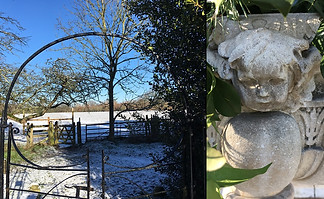
You will soon reach a junction of paths, just past a small copse. Turn sharp right here, still on the Hertfordshire Way, along the edge of a field, initially with trees on your right, to reach a stile and a gate onto Codicote Road. Cross straight over and take the track opposite, following the sign. This is Sheepcote Lane. Follow it along the edge of the woods and over a dismantled railway. Ignore any paths coming off right or left but keep on this muddy track, which then passes under a road. Cross over the footbridge by a ford across the River Lea and continue along the lane ahead, past the farm and houses. When you reach the road, cross over and continue along Dyke Lane. After 150m, look for an information sign and a gate on the right to Devil's Dyke.
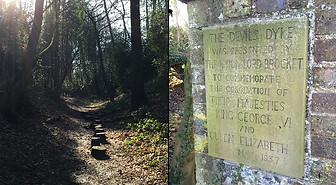
This is a good place to rest up a while (check opening times – at the time of writing, it is closed on Mondays). The pub is named after the writer of The Pilgrim's Progress, who lodged and preached nearby. When you leave the pub, turn left and follow the track down to the lane. Opposite is John Bunyan's Chimney, all that remains of the cottage where he lived. Turn around and head back down the road. After 170m, on the left you will come to a lay-by and a track that goes between trees past a gate. Head down the track following the sign. It runs along the side of a field and then turns right as it enters the next one, heading towards a wood. When you reach the wood, turn right and follow the edge of the trees.

Turn left when leaving the pub then left again down the High Street. There are two more pubs here virtually opposite each other – The Green Man and the Rose & Crown. Just down from The Green Man you will come to the village hall. Take the path along the left side of the hall, which then runs along the top of a cricket pitch. Go through the swing gate and take the path that bears left through the paddocks, going through another swing gate. This crosses a track and comes out at a gate on Sandringham Lane. Cross over and take the track opposite, which passes the back of farm buildings. Ignore the entrance to the wood on the right, but follow the track, which bends round to the left and then continues in the same direction, with Heartwood Forest to your right.
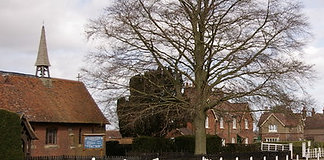
Take the path that cuts across the green opposite St Mary's Church and head towards the white house, which is the park lodge. Continue past the house along a driveway which is bordered by white railings and then through some gates. When the road divides, carry on straight ahead. You will come to some gateposts on your left. This is the entrance to Childwickbury Manor, which dates from the 17th century. The house was once the residence of the film director Stanley Kubrick, who lived there for the last 21 years of his life and is buried in the garden (see panel below).
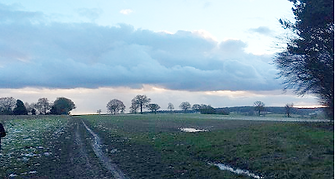
There is an optional diversion here if you are not feeling too tired (see map). It will add an extra 2 1/2 miles to the walk distance. If you turn right up the driveway and continue past Gorhambury House, you will come to the ruins of the old house, once home to Francis Bacon, the Elizabethan scientist and philosopher who was also Lord Chancellor of England. It's an eerily quiet and atmospheric spot. It is a fairly long detour, however, and you have to return the way you came, back down the driveway. If you are skipping this part, just turn left and head down the lane which follows the course of the old Roman highway, Watling Street.
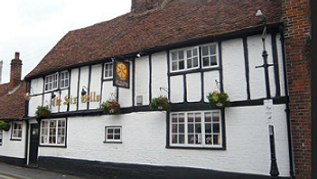
After the pub, continue up the road until you reach the entrance to Verulamium Park on your right. The path runs between the river and a lake and emerges at the recently-reopened Ye Olde Fighting Cocks, allegedly the oldest pub in England. From the pub, on the corner of Abbey Mill Lane, head up through the park towards St Albans Cathedral, which has an amazing astronomical clock. St Albans is a great town to visit and has many places to unwind after the day's excursions (we recommend the Mad Squirrel Tap). The town centre is immediately north of the cathedral, via Waxhouse Gate. The station is just over half a mile away from here, next to The Horn music venue, along Victoria Street.

The path runs alongside a primary school and some houses before going across a field and through some trees and then heading downhill to a road. Turn left and walk down to the junction. Turn left again and at the end of the farm buildings, by a small house, take the track on the right which goes through the yard and continues into the fields. It heads uphill and then levels out after passing a wood. This is part of Ayot Park, the grounds of the 18th-century manor, Ayot House, which you should be able to spot ahead to your right. The path ends at a gate at the bottom of the driveway to the house. Walk down to the lane and turn right to reach the village of Ayot St Lawrence. On your left is the 'haunted' Brocket Arms pub, which dates from the 14th century.
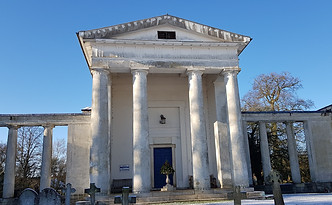
Leave the church via the lane that heads south and meets a road. Turn right and then left by a gate as indicated by the green footpath sign. The path turns right along the edge of a wood and joins a track which becomes an avenue of trees across Lamer Park, leading to Lamer House. Go through the swing gate when you reach the driveway, turn left and follow it south. After about 500m, just as you enter some trees with a house ahead, there is a junction of paths. Go through the swing gate on your left. Keep on this path, with the golf course on your left. This soon becomes a track. After passing the car park and the (closed) country club to your right, take the path on the left through the trees.
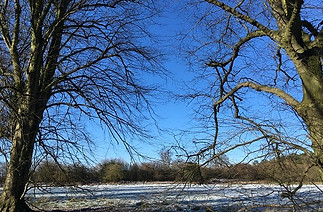
Devil's Dyke is an earthwork that used to form the western defensive ditch of Belgic Oppidum, an Iron Age settlement. The plaque at the entrance alleges that this is where Julius Caesar defeated the British King Cassvellaunus in 54 BC. If you follow the path you will come out near the bottom of the lane. Take the next left down the lane to Beech Hyde Farm. After passing the farm buildings, carry on along the track via a gate. It comes out at a lane by a house. Walk past the house and on the next corner follow the signs and pass through the gates. The path crosses the field and goes through a wood to emerge at the John Bunyan pub.

The path becomes a grassy track and goes past a large house and a paddock before emerging via a gate at Hammonds Lane. Turn right and follow the road for about half a mile. Look out for a pair of iron gates on the left side, just after a bend, and a footpath sign. Take this track, which runs along the edge of a field and passes a wood. It then cuts across another field and emerges via a gate at the edge of Sandridge village. Cross over the residential road and continue along the path opposite. When it reaches a lane, cross over into the churchyard of St Leonard's Church. Pass through the lychgate to reach The Queen's Head pub. You are now over halfway through the walk.
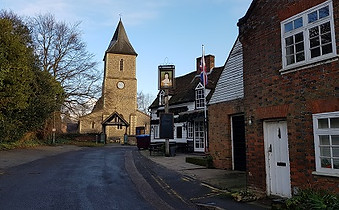
After passing a large field on the left, the path passes another entrance to the wood on the right and then crosses over a railway line via a bridge. Cross over the field and go through the gate to the farm. Go between the farm buildings and take the track on the right. Follow the track as it runs between fields before emerging at gates on the A1081 road. Cross over onto the path opposite and turn right. After 300m, just before a bus stop, turn left through some white gates into Childwick Green, part of the Childwickbury Estate. You will soon reach the village green, which has an old wellhead.

Carry on down the lane. Just over half a mile from the entrance to the house, rather than follow the Hertfordshire Way, take the track on the right via a gate past Woodlands Farm. Follow the lane past some houses and fields. Another track merges from the right before it passes a row of houses and comes out via some white gates onto a busy road. Cross straight over, go through the wooden gate opposite and follow the path along the banks of the River Ver. After 500m, turn right to cross over the river and follow the track across the field. You are back on the Herts Way at this point. The track emerges at the long drive to Gorhambury House.

Just before the driveway reaches the road, on the right you will come to the Roman theatre, the only one of its kind in Britain. Built around 140 AD, the information board describes it as a place built 'for drama, mime shows and absolute mayhem'. It is open daily (closes early evening) and is still used for performances. Cross over the road and go down St Michael's Street opposite, with St Michael's Church on your right. Past the school, turn right for the Verulamium Museum which houses many local Roman artefacts. If you are not visiting the museum, follow the road around to the left to reach the Six Bells, a pub dating from the 16th century.

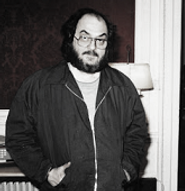
The film director Stanley Kubrick bought 17th-century Childwickbury Manor in 1978 and lived in the 18-bedroom mansion with his wife Christiane until his death in 1999 (Christiane still lives at the property, hosting painting classes and art exhibitions there with her daughter). Moving to England gave Kubrick the time and space to create his films exactly the way he wanted, well away from the Hollywood circus. As well as disliking Los Angeles, he also considered London to be a better film production centre than New York. He initially moved to a large detached house in Barnet, so he could be near Elstree and Pinewood Studios, but The Shining, Full Metal Jacket and Eyes Wide Shut were all made while Kubrick was living at Childwickbury. Often portrayed as a recluse, the reason he spent so much time there was that he used the house as both a home and a workplace. Christiane once described the residence as 'a perfect family factory'.
Childwickbury was large enough for Kubrick to indulge his love of film technology and he converted the stables into additional production rooms. The kitchen featured in The Shining – and it was in the same room that he convinced Steven Spielberg to collaborate with him on the science-fiction film AI. But there are also stories of Kubrick leading a mundane home life (there's a photograph of him surrounded by Waitrose carrier bags and tales of him listening to Test Match Special while eating M&S sandwiches). He died at home in his sleep shortly after attending a screening of Eyes Wide Shut. His funeral was held at the house and attended by around 100 people, with Spielberg, Tom Cruise and Nicole Kidman all giving eulogies. The event was described as 'an English picnic', with classical musicians playing some of Kubrick's most-loved pieces. His resting place is in the garden, beneath his favourite tree. KB

Walks by County
Listed by the most traversed
county for each route
Berkshire
Buckinghamshire
Henley circular
Pr. Risborough-Wendover
Tring circular
Tring-Leighton Buzzard
Cambridgeshire
Cambridge-Trumpington
Whittlesford-Wandlebury
Derbyshire
Edale-Hope
Dorset
Corfe Castle-W. Matravers
East Sussex
Ashdown Forest
Berwick circular
Berwick-Seaford
Cuckmere Haven-E'bourne
Forest Row-Eridge
Glynde-Berwick
Glynde-Seven Sisters
Isfield-Lewes
Lewes circular 1
Lewes circular 2
Lewes-Hassocks
Lewes-Rottingdean
Plumpton-Hassocks
Rye-Three Oaks
Gloucestershire
Kingham circular
Toddington-Cleeve Hill
Hertfordshire
Codicote-St Albans
Odsey-Royston
Kent
Oxfordshire
Surrey
West Sussex
Bramber-Amberley
Steyning circular
West Yorkshire
Haworth-Hebden Bridge
Wiltshire
Avebury circular
